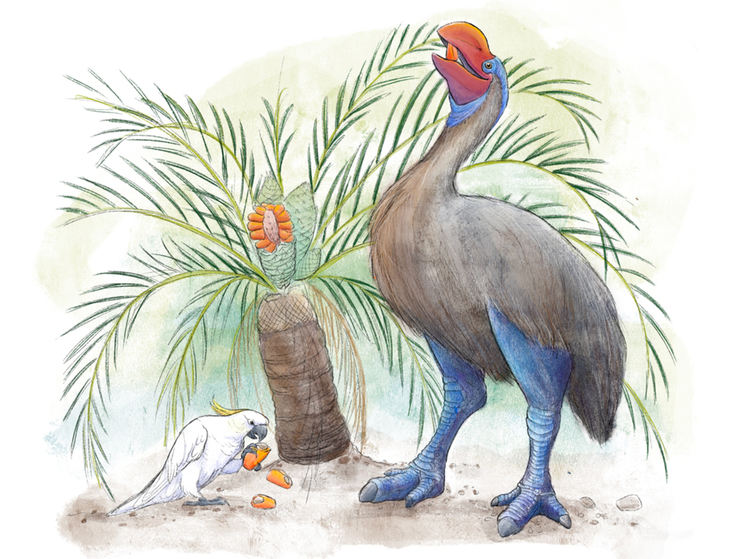Extinct giants were taller than humans and weighed hundreds of kilograms
A rare skull of an extinct large «thunderbird» has been discovered in Australia after scientists searched unsuccessfully for more than a century for a fossilized skull of a species of thunderbird Genyornis newtoni. About 50,000 years ago, these titans, also known as mihirungi, which means “giant bird” in the Aboriginal language, roamed the forests and grasslands of Australia on muscular legs. They were taller than people and weighed hundreds of kilograms.

The last of the Mihirungs died out about 45,000 years ago. The only skull found in 1913 was incomplete and badly damaged, raising questions about the giant bird's appearance, habits and origins, CNN notes.
The discovery of the entire skull of G. newtoni has resolved this long-standing mystery, allowing scientists to come face-to-face with the massive Mihirung for the first time.
G. newtoni stood about 7 feet (2 meters) tall and weighed up to 529 pounds, CNN reports. (240 kilograms). It belonged to the family Dromornithidae, a group of flightless birds known from fossils found in Australia.
Between 2013 and 2019, a team of paleontologists excavated a G. newtoni fossil from Lake Callabonna in southern Australia, revealing multiple skull fragments, a skeleton and an articulated skull, providing the first evidence of a bird's upper beak. The discovery sheds new light not only on G. newtoni but on the entire group of dromornithids, linking them to modern waterfowl such as ducks, swans and geese, scientists reported Monday in the journal Historical Biology.
According to Larry Whitmer, a professor of anatomy and paleontology at Ohio University who was not involved in the study, the new fossils and reconstruction provide important missing details.
“The skull is always the top prize simply because of what is in the head so much important information,” Whitmer notes. – This is where the brain and sensory organs are located, where the feeding apparatus is located, and typically where the display organs (horns, crests, wattles and combs, etc.) are located, he said. “In addition, skulls tend to have structural features that give us clues about their genealogy.”
In the new study, «the authors took everything they had from these new fossils,» Witmer said. The researchers not only modeled the skull bones, but also analyzed the arrangement of jaw muscles, ligaments and other soft tissues that hinted at the bird's biology.
«This latest discovery of new Geniornis skulls has really helped fill in the gaps,» Witmer said.
The newly found skull is central to a digital reconstruction, complemented by other skull fossils and data on modern birds, and provides previously unknown clues about the appearance of G. newtoni, said lead study author Phoebe McInerney, a vertebrate palaeontologist and researcher at Flinders University in South Australia.
“Only now, 128 years after its discovery, can we say what it really looked like,” McInerney said in an email. “Geniornis has a very unusual beak, shaped like a goose.”
Compared to the skulls of most other birds, the skull of G. newtoni is quite short. But the jaws are massive, supported by powerful muscles.
“They had a very wide gape,” says McInerney.
The skull also indicates the diet of G. newtoni. The flat gripping zone in the beak was adapted for tearing soft fruits, tender shoots and leaves, and the flattened palate on the underside of the upper beak may have been used for grinding fruit into a pulp.
“We knew from other evidence that they probably ate soft food, and the new beak confirmed this, McInerney emphasizes. – The skull also showed some evidence of adaptation to aquatic feeding, possibly on freshwater plants.
This suggestion of underwater feeding is surprising given the enormous size of G. newtoni, Whitmer said.
< p>The study authors said the reconstruction helped scientists resolve the controversial ancestry of dromornithids, placing them in the waterfowl order Anseriformes. Judging by their bone structure and associated muscles, dromornithids were likely close relatives of the ancestors of modern South American screamers, duck-like birds that inhabit the wetlands of southern South America.
According to study co-author and paleontologist -ornithologist Jacob Blokland, although G. newtoni had a goose-like beak, its snout did not quite match that of modern geese.
The large flightless emus and cassowaries (which are not closely related to thunderbirds) ) are now found in Australia, but cast a much smaller shadow than the long-extinct mihirungi that still loom large in the popular imagination. She added that much about the anatomy of these extinct giants remains to be seen, such as how gigantism and nonvolatility may have affected inner ear structures associated with head stabilization and locomotion.
























































Свежие комментарии